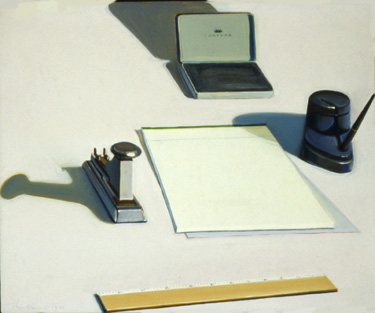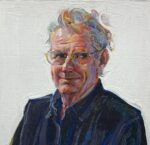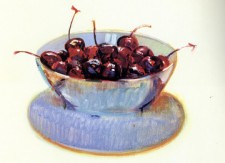
Wayne Thiebaud
American, 1920-
Desk Set, 1971
oil on canvas
18 x 22 in.
SBMA, Gift of Howard and Gwen Laurie Smits
2000.26

Wayne Thiebaud - Self-Portrait, 1993, acrylic on board

Wayne Thieboud, Cherries, 1981 Oil on linen, 12.5X12.5" Private Collection.
COMMENTS
Wayne Thiebaud is an artist who has been categorized as Pop, Billboard-California, photorealist, and iconoclast. He is actually none of these things. Karen Tsujimoto's excellent monograph, Wayne Thiebaud, SFMOMA, 1985, takes us through the rhetoric to the man himself, an unassuming and yet complex person who paints what he loves and loves to paint.
Reared from babyhood in Long Beach, CA., his early career was in advertising and cartooning, though he always worked as an artist. He met the greats of Abstract Expressionism in the 1950's in New York but didn't devote himself exclusively to art until he joined the faculty at UC Davis in 1960, a post he still holds.
In Thiebaud's work we are always confronted with the "telltale signs of our culture," not with irony or sarcasm, but always with a kind of ceremony, a celebration of the amazing in the everyday object. As if the cake in the store window or the hammer on the worker's bench are somehow endowed with a kind of magic arising from our caring for these objects. His architectonic use of light and shadow, so evident in Desk Set above, derive not only from his experience in theater lighting, but also out of his respect for ordinary objects. Unlike Pop art, Thiebaud's objects represent only themselves, not some social conflict or ironic commentary. His link is more truly to tradiional realist American painting.
Other characteristics of his work which elaborate his unique vision are his use of negative space, his always painterly use of the medium, and a kind of reflective nostalgia which invests his objects with a commonality with all people who have admired a cake in a pastry shop window or enjoyed the arrangement of objects on a desk top.
The delights of this painting are almost endless: the sketchiness of the bowl opposed to the brilliant detail of the cherries, the lushness of the cherries themselves, the elevation of the object as an icon to an almost ceremonial display. There is a quality of being totally present in the moment seeing the cherries that reminds us of how inattentive we often are. Take some time to observe the details of the work, the stark line that make the oval recede on either sie of the bowl, the rought strokes that descrb the surface of the bowl. These can really be appreciated in the enlarged version, which is accesey clicking on the image.
Notes made in appreciation for this new acquisition. Ricki Morse
